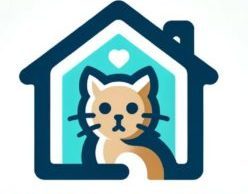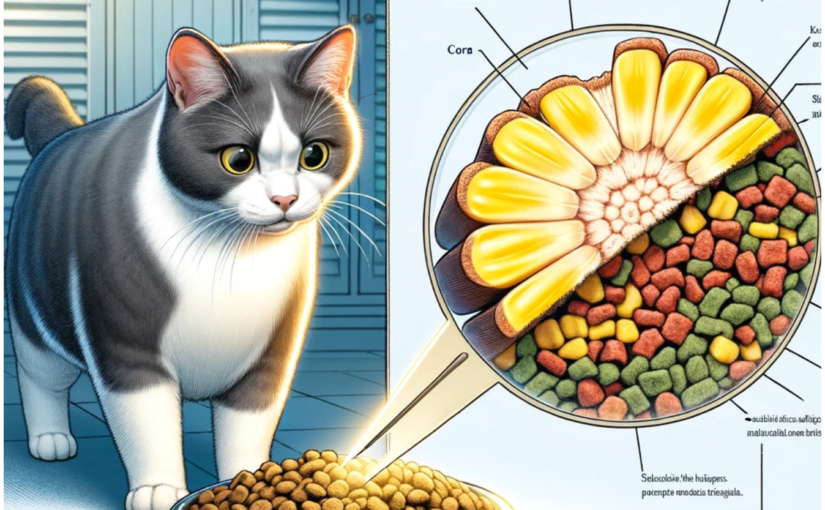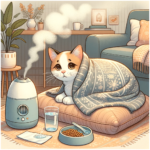When it comes to feeding our feline friends, many pet owners are surprised to find ingredients like corn in their cat’s food. Understanding why manufacturers include corn in cat food and the history of kibble can help us make informed decisions about our pets’ nutrition.
The Cat Food Industry
The global cat food market is a booming industry, expected to reach USD 61.99 billion in 2024 and grow at a CAGR of 7.71% to reach USD 89.85 billion by 2029[3]. With the increasing trend of pet humanization, where pets are treated as family members, the demand for high-quality pet food has surged. This has led to a variety of products, including those that contain corn as a source of carbohydrates.
Corn in Cat Food
Corn is used in cat foods as a high-quality source of carbohydrates, which provide an important source of energy for cats[1]. While cats are obligate carnivores, requiring a diet high in protein, moderate in fat, and low in carbohydrates, commercial cat foods often include grains like corn to offer a balanced diet that meets the requirements of the Association of American Feed Control Officials (AAFCO)[4].
Corn is not traditionally considered a high-quality protein source for cats, especially when compared to animal proteins. Cats are obligate carnivores, which means their bodies are designed to digest and use nutrients from animal sources more efficiently than those from plant sources.
Corn does provide essential fatty acids such as linoleic acid, an omega-6 fatty acid that is required in the diets of dogs, cats, and humans[3]. Corn also contains other nutrients like B vitamins, magnesium, potassium, and carotenoids, which can contribute to overall health[3].
It’s important to note that while corn can be part of a balanced diet for cats, it should not be the primary source of protein. Animal proteins should still be at the forefront of a cat’s diet to ensure they receive all the essential amino acids they require.
Corn protein meal, previously known as corn gluten meal, has been used in pet food for over a century and is considered a high-quality protein source that contains no gluten[5]. So while corn and corn-fermented protein can be included in cat food and provide certain nutritional benefits, they should not replace high-quality animal proteins as the main protein source in a cat’s diet. Further research is encouraged to evaluate the use of these ingredients at lower inclusion levels and to better understand their role in cat nutrition[12].
It should be noted, recent research has explored the potential of corn-fermented protein (CFP) as an alternative protein source in pet foods. And those studies have indicated that CFP can be an acceptable ingredient in dog and cat diets[12]. Corn-fermented protein is a co-product from ethanol production and contains approximately 20% to 25% yeast, which may contribute to its nutritional value[2]. The research suggests that while CFP is less nutrient-dense than animal proteins, it has less variation in nutritional content compared to animal protein meals, making it a consistent source of nutrients[1].
It’s important to note that while corn is not harmful to cats, it doesn’t offer substantial nutritional value and mostly acts as a filler[5]. Cats do not digest carbohydrates as efficiently as animal proteins, and excessive carbohydrates can lead to health issues such as obesity and diabetes.
Kibble History
The history of commercial pet food is a fascinating tale of innovation and marketing. The world’s first commercial pet food was developed in 1860 by James Spratt, and since then, the industry has evolved significantly[2]. The first dry kibble was produced in 1956 through a process called extrusion, which allowed for the mass production of shelf-stable pet food[2]. This process is still used today because it facilitates flexibility, density control, and optimizes product shelf-life, although it can impact the nutrient composition of the food.
Nutrition and Health
When selecting a cat food, it’s crucial to ensure that it is complete and balanced, and that meat, meat byproducts, or seafood are listed among the first few ingredients[4]. This indicates that the food likely contains enough animal-source ingredients to supply essential amino acids and fatty acids. Homemade diets are generally not recommended unless formulated by veterinarians certified in animal nutrition, due to the complexity of meeting a cat’s nutritional needs[4].
Conclusion
Corn in cat food serves as a source of energy but does not provide significant nutritional benefits for cats. The history of kibble shows a shift from raw and fresh foods to convenient, shelf-stable products. As pet owners, it’s our responsibility to read labels carefully and choose diets that meet our cats’ specific nutritional requirements, keeping in mind their carnivorous nature. With the cat food industry continuing to grow, it’s likely that we will see further innovations in cat nutrition, hopefully with a focus on health as well as convenience.
Citations:
[1] https://www.iams.com/cat/cat-articles/corn-ingredients-and-their-use-our-cat-foods
[2] https://www.thefarmersdog.com/digest/the-history-of-commercial-pet-food-a-great-american-marketing-story/
[3] https://www.mordorintelligence.com/industry-reports/global-cat-food-market-industry
[4] https://www.vet.cornell.edu/departments-centers-and-institutes/cornell-feline-health-center/health-information/feline-health-topics/feeding-your-cat
[5] https://www.pawlicy.com/blog/can-cats-eat-corn/
[6] https://www.stevesrealfood.com/2018/10/31/the-surprising-history-of-commercial-pet-food/
[7] https://www.futuremarketinsights.com/reports/cat-food-market
[8] https://catinfo.org
[9] https://www.reddit.com/r/cats/comments/6eo0fl/rant_on_sudden_food_ingredient_change_discussion/
[10] https://fotp.com/learn/dog-food/the-history-of-kibble
[11] https://www.grandviewresearch.com/industry-analysis/cat-food-market-report
[12] https://www.petmd.com/cat/nutrition/cat-nutrition-what-makes-nutritional-cat-food
[13] https://pubmed.ncbi.nlm.nih.gov/34078195/
[14] https://www.petfoodinstitute.org/about-pet-food/nutrition/history-of-pet-food/
[15] https://www.gminsights.com/industry-analysis/cat-food-and-snacks-market
[16] https://www.lombardvet.com/services/cats/feline-nutrition-cat-food
[17] https://vcahospitals.com/know-your-pet/nutritional-benefits-of-corn-and-grains-for-dogs-and-cats
[18] https://animalwellnessmagazine.com/commercial-pet-food/
[19] https://www.alliedmarketresearch.com/cat-food-market-A14188
[20] https://vcahospitals.com/know-your-pet/nutrition-feeding-guidelines-for-cats
[21] https://www.hillspet.com/about-us/nutritional-philosophy/pet-food-facts/is-corn-bad-for-pets
[22] https://rogueraw.com.au/pages/history-of-pet-kibble
[23] https://www.statista.com/topics/1369/pet-food/
[24] https://truthaboutpetfood.com/the-corn-gluten-meal-cover-up/
[25] https://nycdoggies.com/wellness/dog-food-the-story-of-kibble/
[26] https://www.petfoodprocessing.net/articles/17581-state-of-the-us-pet-food-and-treat-industry-2023
[27] https://www.lovemeow.com/does-your-cat-food-contain-corn-as-a-primary-ingredient-1607969737.html
[28] https://en.wikipedia.org/wiki/Dog_food
[29] https://www.petfoodindustry.com






